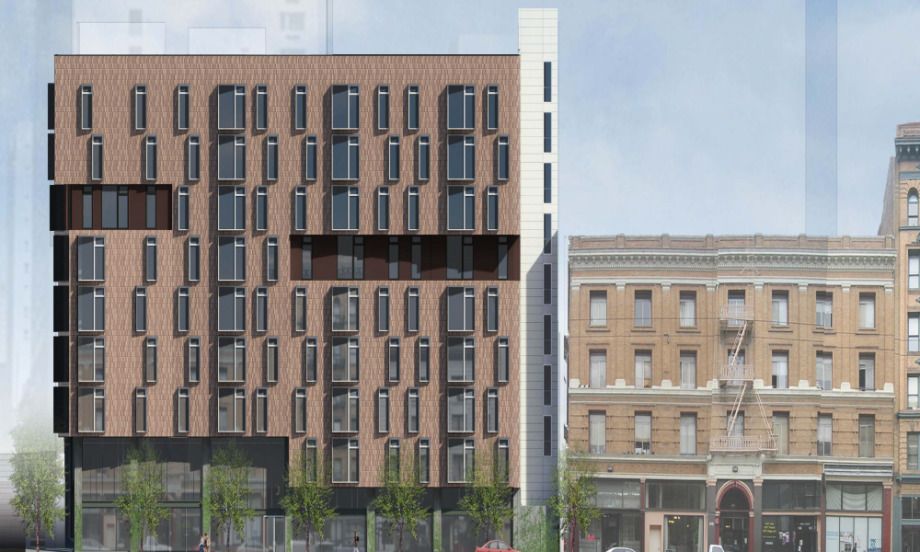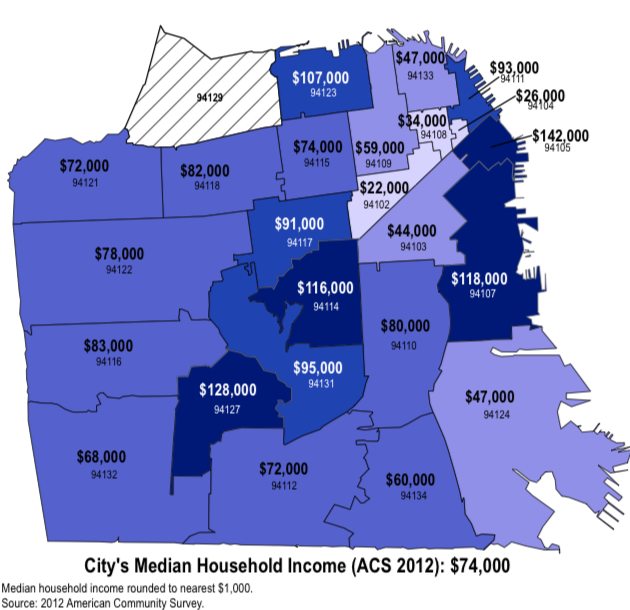Like a bull’s-eye, San Francisco’s poorest neighborhood is surrounded by some of its wealthiest. In the Tenderloin, as it’s known, median household income is $22,000. Many residents are among San Francisco’s youngest; at least 3,000 children live in the Tenderloin. In large part, their families moved there to secure more affordable housing: Some 80 percent of 15,800 total apartments are either rent-controlled or locked-in at below-market rates, according to the San Francisco Business Times. But that housing supply doesn’t quite meet residents’ needs.
Don Falk, CEO of the Tenderloin Neighborhood Development Corporation (TNDC), estimates that 95 percent of Tenderloin homes are studios or single-room occupancies (SROs), a legacy of earlier times when the neighborhood served a different population. “There is a lot of overcrowding,” Falk says.
Nonprofits like TNDC and Mercy Housing started buying up buildings in the Tenderloin in the 1980s, and preserving their affordability. The city of San Francisco, too, worked with investors using Low Income Housing Tax Credits to acquire buildings in the Tenderloin and maintain them as affordable housing.
Today, TNDC owns and manages about 3,500 units of housing, mostly in the Tenderloin but also in some other San Francisco neighborhoods. Ninety percent of their tenants make less than 30 percent of San Francisco’s area median income (AMI), currently $34,600 for a family of four.
For years, TNDC has wanted to build affordable housing in the Tenderloin that’s suitable for families with children. New construction is the only way to do it, Falk says, because gutting and rebuilding a big SRO building is too expensive.
And though it’s taken a decade of hard work, TNDC finally broke ground in August on the Eddy & Taylor Family Apartments, an 8-story, 113-unit building, on one of the last undeveloped parcels in the Tenderloin. The former parking lot is in a highly desirable location, two blocks from a regional commuter train stop. One hundred percent of the units will be locked in at below-market rents. Sixty percent of the units will be two- or three-bedroom units. Thirty percent of the units will be reserved for families coming out of the shelter system. Five units will be reserved for people with developmental disabilities.
The project could have been a lot bigger; the building was originally slated to be 157 units, 100 percent affordable, and 14 stories instead of just eight. But between the recession and some abrupt policy decisions by the state, TNDC had to scale back to move ahead. A project like this, with larger units suitable for families with children, is a heavier lift because of the way affordable housing finance works.
A “Straightforward” Affordable Housing Plan
In 2007, TNDC moved to acquire the site. “We’re competing on the private market to buy property,” says Falk. “No favors, no gifts. We’re outbidding others and trying to convince the seller we are going to close in a timely way.”
TNDC got a loan from Bank of America for half the acquisition cost. The other half came from the Mayor’s Office of Housing and Community Development, in the form of a deferred loan (meaning it doesn’t require any payments until the loan term is up or it’s paid off early).
Property in hand, TNDC developed a plan for 157 units, 100 percent affordable. With city backing on the deal, the state promised financing too, also in the form of a deferred loan. The deferred loan structure is typical in affordable housing finance, allowing the public sector to enforce affordable housing agreements. If the owner doesn’t maintain affordable rents or keep the building up to code, the city or state can foreclose and take control of the building.
“It was in a sense a relatively straightforward plan,” says Falk. But then the recession hit, and it was before building design and contracting were complete, so the city and state dollars that were promised weren’t yet disbursed. “By 2009, the state had run out of money. We were in the Great Recession. The governor [and] legislature were not willing to replenish those funds,” says Falk.
The project stalled. In 2011, the bank loan was due for repayment. TNDC needed to pay it off.
The Low Income Investment Fund (LIIF), a CDFI (community development financial institution) that had just helped launch the Transit-Oriented Affordable Housing Fund (TOAH), to support equitable transit-oriented development in the Bay Area, stepped in. Thanks to its proximity to public transit, the Eddy & Taylor Family Apartments became the first project under the TOAH Fund, which extended a loan to refinance the loan and get the bank out of the picture.
The TOAH loan bought TNDC more time to find the financing to pay for design and construction. “That’s the major niche TOAH fills, the need for acquisition and predevelopment funding, to get from a vacant site through predevelopment to prebuild to securing the funding for construction, which we’ve seen with Eddy & Taylor can take quite a while,” says LIIF’s Craig Adelman.
But just as things started looking up, the state of California decided to dissolve its redevelopment authorities — local agencies created in the 1940s to encourage urban redevelopment. Eddy & Taylor Family Apartments was one of many projects around the state that were left in limbo as a once reliable source of affordable housing finance disappeared.
TNDC cooked up a plan to attract private capital by reducing the affordable units in the project to just 50, leaving the rest as market-rate. “We needed an impact investor, someone willing to take a below-market rate return on a $15 million investment in order to get the 100 market-rate units built,” Falk says.No one bit on the deal.
Getting family-size apartments through the affordable housing finance process can also be challenging because affordable housing finance is typically distributed on a per-unit basis, with only marginal consideration for unit size. In other words, three studio units will typically generate more financing through deferred loans or tax credits than one three-bedroom apartment.
“We can house just as many people with 100 family units as 175 studios, but with 175 studios we can generate a lot more subsidy,” Falk says.
The subsidies and tax credit financing tools lean toward boosting unit counts because that’s typically what gets headlines. “If you’re a housing official, in the public sector, the most regularly quoted statistic that anybody hears is how many units of affordable housing you’ve produced,” says Adelman.
The saving grace for Eddy & Taylor Family Apartments came from another new source of funding: California’s cap and trade program, which was structured to set aside 20 percent of the state’s proceeds under the program for affordable housing. An $11.7 million deferred loan financed through that program finally got the ball rolling again on the project — with a shortened path after TNDC scaled the project down to 113 units.
“Its journey really tells the story of affordable housing in San Francisco over the last decade,” Falk says.
The construction is scheduled to take two years. Next on Eddy & Taylor’s agenda: signing up a full-service grocer for the ground floor.

Oscar is Next City's senior economic justice correspondent. He previously served as Next City’s editor from 2018-2019, and was a Next City Equitable Cities Fellow from 2015-2016. Since 2011, Oscar has covered community development finance, community banking, impact investing, economic development, housing and more for media outlets such as Shelterforce, B Magazine, Impact Alpha and Fast Company.
Follow Oscar .(JavaScript must be enabled to view this email address)

















